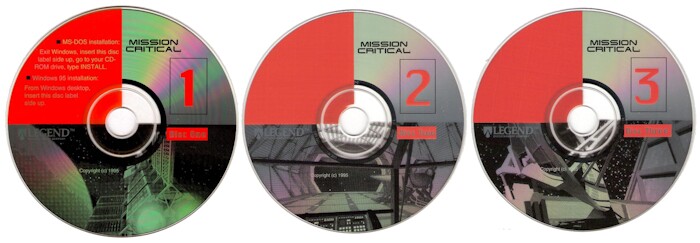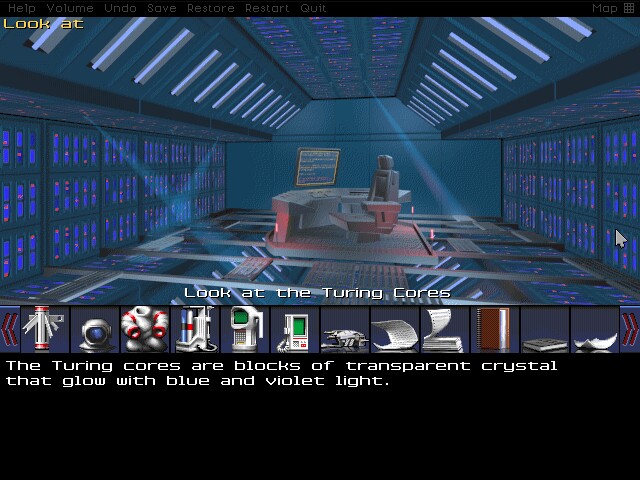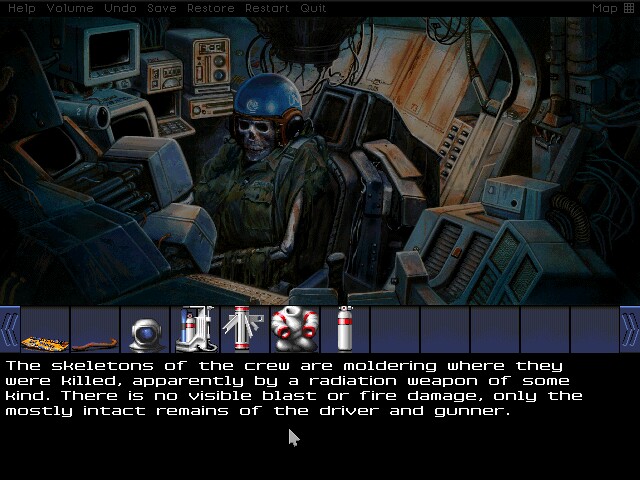
Actual Game
Mission Critical1-Click Install
|
The Game
In 2134, the United Nations and the Alliance are in a desperate battle; each side fights to preserve its own way of life. Light years from Earth, the USS Lexington is en-route to complete a secret mission that may tip the balance of this war. Unbeknownst to the crew, however, a UN heavy cruiser lays in ambush. Outgunned, forced to surrender, and on the brink of desperation, Captain Dayna (played by Michael Dorn of Star Trek: The Next Generation fame) orders Lt Commander Tran (played by Patricia Charbonneau) to plant a nuclear warhead in the shuttle they will use to ferry over to the UN vessel, setting it to detonate upon entry. Only you are left onboard the starship Lexington to complete its unspoken mission.
Despite its epic storyline, the complex plot unfolds progressively and logically throughout the course of the game. Through an exploration of the Lexington and the surface of the mysterious world Persephone, you slowly learn about the conflict that engulfs the human race, the mission with which you have been charged, and ultimately, are forced to ponder some of the existential questions that surround humanity's relation to progress, technology, and the nature of artificial intelligence.
Like a well written sci-fi novel, in a good game such as Mission Critical, the player can identify with a future that is well researched, detailed, and consistent. Although much of the techno babble is evocative of the Star Trek universe, Mission Critical is set in its own grim world, lacking all of Star Trek's utopian elements. Moreover, it is Verdu's attention to every detail in the game that makes the secondary world he has created so wonderful and real. Every function and area of the Lexington has been painstakingly mapped out, from the complex Tal-Seto Jump Drive, to the Turing Cores of the main computer, to the extensive documentation for the experimental Hype-Telecon system. The game is graced with the well written dialog and description that have characterized all of Legend Entertainment's past interactive fiction and graphical adventure games.
The graphics in Mission Critical are detailed and well done, and they convey a sense of the dystrophic world portrayed by the game. The cut scenes and character interaction are all rendered in Full Motion Video (FMV), a technology in vogue during the mid 1990s. This gives the game a certain photorealistic quality, and at times makes it seem like an interactive movie. Yet, certain live action sequences in the game are very jerky, making it difficult to click any object on screen during these sequences.
The gameplay in Mission Critical lives up to the high standards of other titles from Legend Entertainment. The first-person interface, a slightly updated version of the interface found in the company's other game titles, is simple and intuitive. Clicking on a hotspot gives you a list of text choices on the side of the screen regarding the manipulation of the selected object, with the most logical choice automatically highlighted. When you are able to walk from a particular area to another, a red cursor appears. Following the cursor generates a somewhat slow and annoying video sequence in which you ease forward into the next room or area, but this can be bypassed by some assiduous double-clicking.
The game manages to integrate a number of arcade styled space combat sequences. Although they make perfect sense in context, some gamers (and I) who think that these elements do not belong in adventure games can allow the computer to take control and just sit back and watch.
Legend Entertainment's specialty has always been puzzles. As in the company's other games, the puzzles in Mission Critical are mostly inventory based, and all of them are extremely logical and well integrated into the plot. Only Verdu can find so many creative ways for you to reuse your inventory items. Although the puzzles in Mission Critical do not reach the ingenuity of, say, the company's other fantasy adventure game Death Gate, they are still quite enjoyable to solve. Perhaps because the puzzles make so much sense, the game may even seem a little too easy at times. Although a great deal of the game remains to be explored once you depart the Lexington, the puzzles from that point onward are quite elementary, and most players will probably be able to complete the rest in a single sitting.
All in all, Mission Critical is a masterpiece of science fiction and adventure gaming. With its attention to detail and quality writing, Mission Critical harks back to a nearly forgotten time when computer game designers focus not on breathtaking eye candy but on crafting an engaging story. If only the talented developers at Legend Entertainment were still in business, the world of adventure gaming would be a brighter place.






